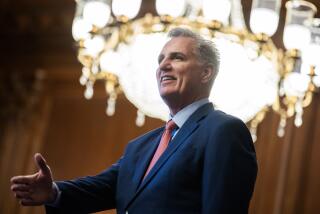Taking the Lead
A few California politicians grumble quietly about a capricious limit on government spending that in time will smother state efforts to deal with the present, let alone cope with the future.
Bill Honig, the state superintendent of public instruction, is not one of them. No quiet grumbler, he is mounting a head-on attack against the misbegotten 1979 constitutional amendment that imposed the limit, and he deserves the support of every business and community leader and all other Californians who care about where the state is heading.
At first glance, the odds against Honig seem steep. They seem to make his first crusade of four years ago for better public schools and more money to keep them that way look like a milk run. After all, 75% of all Californians who went to the polls in 1979 voted for the proposal that puts a ceiling not only on the amount that Sacramento can spend in a given year but also on the amount that local governments can spend on such things as street repair and firefighting.
A closer inspection shows that he has a fighting chance. The limit was imposed in a special election by a mere 19% of the state’s eligible voters; that gives him an immense audience to which to argue that California is approaching arbitrary limits to growth that will not only take the steam out of Honig’s school reforms but also stifle every other government program that helps make California livable. Election statistics are not all that Honig has going for him. He has ferocious energy, a sure grasp of the problem, a vision of the way California can grow if it is allowed to, and a habit of leveling with people.
The fundamental flaw in the 1979 initiative, sponsored by Paul Gann, is that government spending cannot increase in any given year by more than the consumer price index, with an adjustment for increases in population. But the index is no measure of the need for government services because it is blind to everything except price.
The index cannot measure increases in students, in traffic congestion or in potholes; it cannot see a need for new parks or libraries. It has no way of knowing when highways are no longer adequate for manufacturers and farmers to get their products and produce to market. It cannot tell when a new sewage-treatment plant is needed to protect public health. The index can tell only when to stop spending, no matter how urgent the unfinished business of coping with growth.
We would rather see the limits abolished altogether, but Honig argues persuasively that a change in the formula that sets the limits would serve the purpose. Instead of using a price index, Honig would use personal income, which has been growing faster than prices by about 2% a year, as the guide to spending limits. It is also possible that a campaign that tries to persuade voters to amend the formula will succeed where one that urges them to ditch it will not. And Honig’s approach certainly will be better than no change at all.
The arguments for a change in education alone are monumental. Honig calculates that the public schools in California need increases of $750 million a year just to stand still; when the spending limits take hold next year, they would shortchange schools by a total of $2 billion in just four years. The state, which already lags behind New York in the amount that it spends per pupil by $2,100 a year, would fall behind even further. That will not do, even for the present, in the largest and wealthiest state in the nation, and it certainly will not do for the kind of bright future to which California aspires as a natural leader of the West and of the Pacific.
The same grim picture shows up in other areas. Urban highways already are jammed to capacity during rush hours. With an anticipated population of 7 million by the turn of the century, they would by then be jammed to coagulation without major commitments to rail transit and, where possible, to new or wider highways.
Thus Honig, no quiet grumbler, is once again leading the way in a good cause. He is entitled to the widest possible following.
More to Read
Get the L.A. Times Politics newsletter
Deeply reported insights into legislation, politics and policy from Sacramento, Washington and beyond. In your inbox three times per week.
You may occasionally receive promotional content from the Los Angeles Times.






